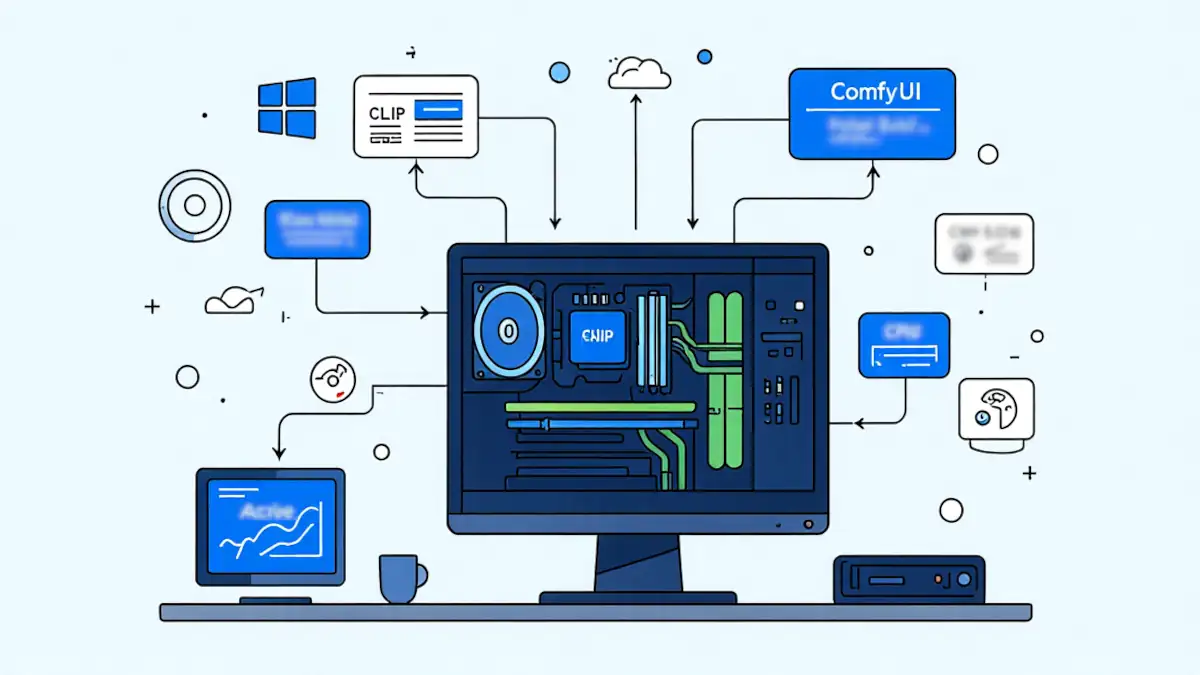ComfyUI freeze on Windows 11: how to avoid it with CLIP models and CPU offloading?

ComfyUI is now one of the key tools for orchestrating complex generative AI workflows. But for many advanced users, a persistent problem ruins the experience: freezes and system crashes when using large CLIP models (such as UMT5_XXL or T5XXL) with CPU offloading on Windows 11.
These crashes, sometimes without any error message, often force a full PC restart. Where does the problem come from? Are there any solutions? This guide summarizes the issue, with sources and tips included.
Understanding the problem: ComfyUI freezes, CPU offloading and large CLIP models
Many user reports on GitHub and Reddit highlight this phenomenon: when ComfyUI loads a large CLIP model (like UMT5_XXL) with the Device=CPU parameter (CPU offloading), random but frequent freezes occur on Windows 11, and even on Linux.
The symptom is severe: the entire system crashes with no usable logs, forcing a hard reboot. When using the software frequently, this makes it almost unusable. This was my case, so I started investigating to fix the bug and regain ComfyUI’s initial stability.
At first, I thought it was a hardware issue. But by isolating workflows and running many tests, I finally found the cause.
Identified causes: memory management, CPU offloading, and software bugs
The main causes of ComfyUI freezes with CPU offloading on Windows 11 are now well documented within the community:
1. RAM saturation or memory leaks
When a large CLIP model is loaded on the CPU, RAM usage skyrockets. Some users have observed that ComfyUI (or Python) does not always properly release memory between runs, creating memory leaks that saturate the system and freeze Windows 11 (GitHub).
Watch out: If RAM usage reaches 100% in Task Manager, it’s a clear sign of memory exhaustion or leaks.
2. Inefficient handling of CPU offloading
CPU offloading is meant to free up GPU VRAM by transferring tasks to the processor. But on large models like UMT5_XXL, this process puts a heavy load on RAM, CPU, and memory bus, sometimes causing a full system crash Reddit.
3. Instabilities introduced by recent updates
Since the introduction of certain modules (for example, Flux support), memory management bugs have been reported, increasing instability when using large CLIP models with CPU offloading GitHub Discussions.
4. PC configuration instability
Another common cause is workstation instability: BIOS settings, overclocking, RAM tuning or other adjustments. Even a slight CPU overclock or RAM frequency tweak can introduce instability when the CPU is under heavy load.
To isolate the problem, revert to default CPU and RAM settings. Then test with an intensive ComfyUI workflow—if the freezes disappear, that’s the cause. You can then gradually reapply settings and test after each change to identify the culprit.
Note: some RAM sticks, even running at official frequencies, can cause instability—especially on AMD setups with four RAM sticks installed.
ComfyUI freeze on Windows 11: symptoms and diagnostics
Symptoms
- Total system freeze (nothing responds), desktop remains displayed
- Forced reboot required (no usable logs)
- Sometimes a Blue Screen of Death (BSOD)
- Random crashes but frequent, especially with large CLIP models
Diagnostics
- No hardware issue detected (high-end PC, 64–128 GB RAM, RTX 4090 or equivalent)
- Freezes affect both Windows 11 and some Linux distributions (but seem more frequent on Windows, according to GitHub Issues)
Solutions and best practices to avoid ComfyUI freezes on Windows 11
1. Reduce model size or workflow complexity
Freezes are proportional to model size. Choosing a smaller CLIP model (for example, CLIP-L/14 instead of UMT5_XXL) greatly reduces memory load.
Using quantized models, the GGUF format can significantly reduce VRAM and RAM usage.
2. Monitor memory usage in real time
Before launching a workflow, open Task Manager (Ctrl+Shift+Esc):
- Monitor RAM and CPU usage evolution.
- If memory approaches maximum capacity, stop ComfyUI and restart the app.
3. Restart ComfyUI (and Python) between heavy generations
After each heavy run, fully quit ComfyUI (and Python). This forces memory release and prevents accumulation of memory leaks Reddit.
4. Test ComfyUI flags and memory options
ComfyUI offers several memory management options you can try in launch parameters:
- –lowvram : useful on low VRAM systems, moves text encoder to CPU
- –cpu : forces all processing on CPU (slow, last resort)
- –reserve-vram [GB] : reserves VRAM for the system
- –async-offload : enables asynchronous memory offloading
(See official ComfyUI documentation for details)
5. Try community forks or specialized wrappers
Forks like ComfyUI-MixedProcess, ComfyUI-MultiGPU, or wrappers like HunyuanVideoWrapper offer optimized CPU offloading and memory management. These are recommended if ComfyUI is unstable with your workflows (see Reddit).
6. Update your entire environment
Make sure ComfyUI, Python, GPU drivers, and dependencies are all up to date: several critical memory management bugs have been fixed in recent releases (ComfyUI Release Notes).
7. Limit CPU offloading for very large models
If freezes persist, the most reliable solution is to avoid CPU offloading for models like UMT5_XXL and T5XXL, at least until ComfyUI provides a proper fix.
Keep an eye on future updates in ComfyUI or community wrappers for better CPU offload support.
Summary table of causes and solutions
| Symptom | Probable cause | Recommended solution |
|---|---|---|
| Total system freeze | Memory leak / RAM saturation | Use smaller model, monitor RAM, restart |
| No error logs | OS-level crash | Simplify workflow, monitor external tools |
| Freeze during CPU offloading | Inefficient offload | Memory flags, community forks |
ComfyUI freeze: Windows 11 vs Linux
According to user reports, crashes and freezes occur on both Windows 11 and Linux, but memory management seems slightly better optimized under Linux (Reddit).
To verify: test the same ComfyUI workflow on a recent Linux machine and compare stability.
Advanced tips for heavy ComfyUI workflows
- Break down overly complex workflows into smaller steps
- Use checkpoints and frequent saves
- Avoid combining CPU offloading with other RAM-intensive apps
- Monitor swap/disk usage: a saturated swap can also cause system freezes
What to watch for in the future
- Evolution of ComfyUI forks and wrappers
- Release of patches for memory management and CPU offloading
- User feedback on stability in newer versions under Windows 11 vs Linux
Conclusion
ComfyUI freezes on Windows 11 are a common issue, even on high-end PCs. The problem is particularly frequent when using CPU offloading on large CLIP models, though freezes can also happen without CPU offloading enabled.
The root cause lies mostly in poor memory management and suboptimal CPU offloading for very large models. Until ComfyUI developers or related frameworks provide a definitive fix, it’s best to use lighter models, monitor RAM usage, restart between heavy tasks, and explore more stable community forks or wrappers. Adjust workflows to avoid maxing out RAM and leave a safety margin for GPU VRAM as well.
Finally, always keep your environment updated and pay close attention to community feedback and troubleshooting tips.
Your comments enrich our articles, so don’t hesitate to share your thoughts! Sharing on social media helps us a lot. Thank you for your support!






